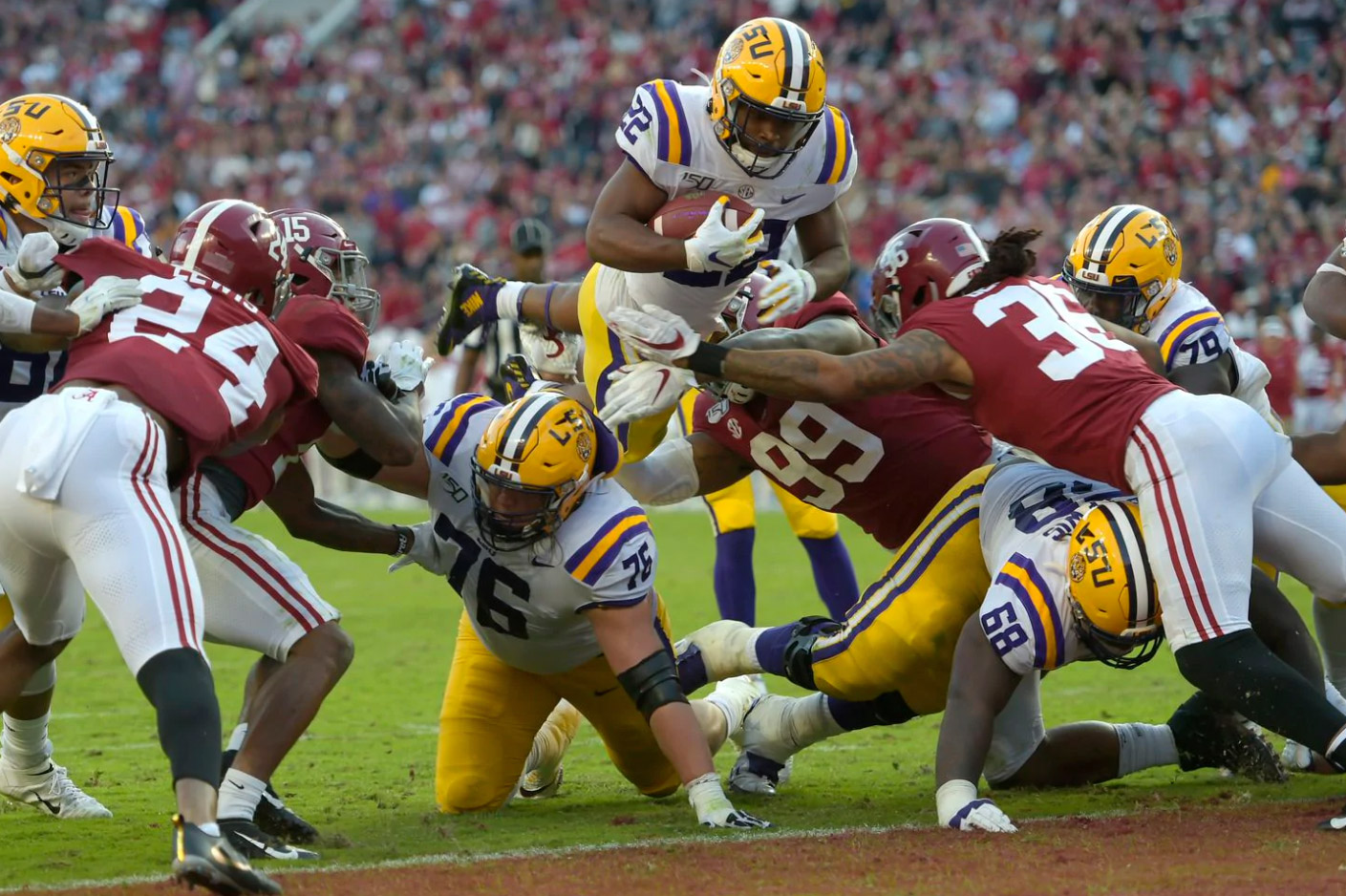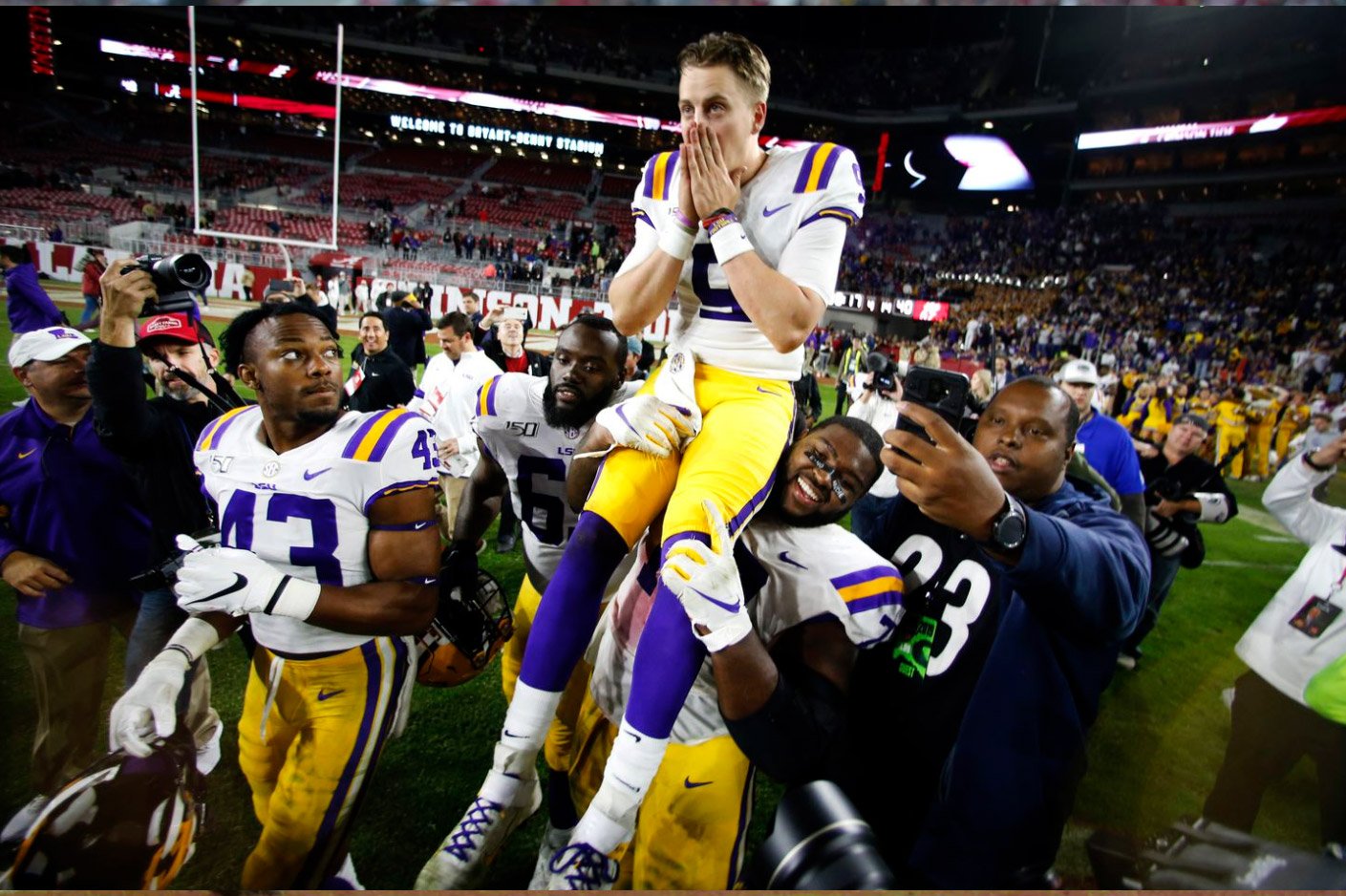The LSU Tigers football program, also known as the Fighting Tigers, represents Louisiana State University in the sport of American football. The Tigers compete in the Football Bowl Subdivision (FBS) of the National Collegiate Athletic Association (NCAA) and the Western Division of the Southeastern Conference (SEC).
LSU ranks 16th most in victories in NCAA Division I FBS history and claims three National Championships (1958, 2003 and 2007), 15 conference championships, and 35 consensus All-Americans. As of the beginning of the 2018 NFL season, 40 former LSU players were on active rosters in the NFL, the second most of any college program.
The team plays in Tiger Stadium and Ed Orgeron is the head coach.
History
Louisiana State University (LSU) played its first football game in school history on November 25, 1893, losing to rival Tulane in the first intercollegiate contest in Louisiana. The game sparked a rivalry between the Tigers and the Green Wave that has lasted generations. The Tigers were coached by university professor Dr. Charles E. Coates, known for his work in the chemistry of sugar. Future Louisiana governor Ruffin G. Pleasant was the quarterback and captain of the LSU team. In the first game against Tulane, LSU football players wore purple and gold ribbons on their uniforms. According to legend, purple and gold were chosen because they were Mardi Gras colors, and the green was sold out. The rules of play in 1893 were more like rugby than what might be considered modern football.
LSU achieved its first victory by beating Natchez Athletic Club 26–0 in 1894. Samuel Marmaduke Dinwidie Clark has the honor of scoring the very first touchdown in LSU history. The first football game played on the LSU campus was at State Field on December 3, 1894, a loss against Mississippi. LSU’s only touchdown in that game was scored by the head coach, Albert Simmons. This was the first year of play for William S. Slaughter who lettered as an end for 5 years (1894, 1895, 1896, 1897, 1898). Slaughter was LSU’s first five time football letterman. By 1895, LSU had its first win in Baton Rouge.
Building the program (1900–1934)
Chavanne was rehired in 1900, posting a 2–2 record. He was replaced by W. S. Borland as head coach in 1901, who led the team to a successful 5–1 season. After a 22–2 loss to Tulane, LSU protested to the SIAA and alleged that Tulane had used a professional player during the game. Several months later, the SIAA ruled the game an 11–0 forfeit in favor of LSU. The seven-game 1902 season was the longest yet for the Tigers and also featured the most games on the road. The 1903 season broke the previous season’s record, with nine games. Dan A. Killian coached the team from 1904 to 1906. Running back René A. Messa made the All-Southern team in 1904.
Edgar Wingard coached the team in 1907 and 1908. In 1907, LSU became the first American college football team to play on foreign soil in the 1907 Bacardi Bowl against the University of Havana on Christmas Day in Havana, Cuba. LSU won 56–0. John Seip ran back a 67-yard punt return.
The 1908 team posted an undefeated 10–0 record. Quarterback Doc Fenton led the nation in scoring with 132 points. He threw a 40-yard touchdown pass to Mike Lally in the win over Auburn. The National Championship Foundation retroactively awarded 1908 LSU the national championship though it is not claimed by LSU. This season also led to an SIAA championship; but was clouded by accusations of professionalism from rival school Tulane. Auburn and Vanderbilt were among those listed as alternative conference champions.
1910 was a disastrous year for the Tigers. After a strong 1909 campaign which saw their only conference loss come to SIAA champion Sewanee, the team lost some star power with Lally, Seip, and center Robert L. Stovall all graduating. In 1912, coach Pat Dwyer developed a “kangaroo play” in which back Lawrence Dupont would crawl between offensive lineman Tom Dutton’s legs; supposedly very effective in short yardage situations. Fullback Alf Reid made the All-Southern team in 1913.
LSU’s largest loss margin came on October 31, 1914 in a game against Texas A&M in Dallas, Texas. In 1916, three coaches led the team for parts of the season. The coaches were E. T. MacDonnell, Irving Pray, and College Football Hall of Fame coach Dana X. Bible. Due to World War I, no games were scheduled or played for the 1918 season by LSU. Pray also served as head coach full seasons in 1919 and 1922, compiling a total record of 11–9 at LSU. In 1923, Mike Donahue left Auburn to become the seventeenth head football coach at LSU. 1924 saw the first game played at the newly built Tiger Stadium, with an original seating capacity of 12,000. Donahue retired after the 1927 season. Vanderbilt coach Dan McGugin recommended Russ Cohen for the LSU coaching job, which he accepted in 1928. That season, offensive tackle Jess Tinsley made the All-Southern team. In 1931 LSU played its first night game in Tiger Stadium, a 31–0 victory over Spring Hill. In Biff Jones’ first season as head coach, the 1932 team tied for the Southern Conference championship in its last season as a member of the conference. The season included a five-game winning streak in which LSU outscored its opponents by a combined 162–0.








